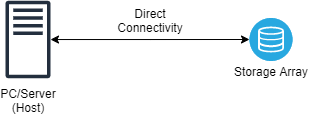Data has become the cornerstone of any technological application arising the need to store and access data reliably and efficiently. The ever-growing need for storage innovations in storage-related technologies has given rise to different storage methods to power consumer and enterprise needs. In this post, we will look at the following storage technologies while comparing their features and use cases.
- Direct Attached Storage (DAS)
- Network Attached Storage (NAS)
- Storage Area Network (SAN)
In this article, we’ll look at each and help you determine which is best for your use case.
What is Direct Attached Storage (DAS)?
Direct attached storage is the simplest storage type: a storage device is directly attached to a host device. A typical example of a DAS is an external storage device attached to a pc or a server. DAS devices can consist of multiple hard drives in a single enclosure without any network connectivity. Following are some of the connectivity options that can be utilized for Direct Attached Storage devices:
- USB (Universal Serial Bus)
- SATA (Serial Advanced Technology Attachment)
- eSATA (External Serial Advanced Technology Attachment)
- SAS (Serial Attached SCSI)

Advantages of DAS
Performance is the primary advantage of Direct Attached Storage as the devices are the performance. As the storage is directly attached to a host machine, it can provide the best performance and latency, only subject to the inherent limitations of the connectivity interfaces. They can be cost-effective solutions with limited maintenance requirements depending on the configuration.
Disadvantages of DAS
DAS is not suitable for providing storage connectivity to multiple users or devices due to their directly attached nature and not having network connectivity. Additionally, DAS has limited expandability, which is limited by the number of connections a host pc can utilize and the number of drives the DAS solution supports.
What is Network Attached Storage (NAS)?
NAS or Network Attached Storage is by far the most popular storage solution for both consumer and enterprise users. It is a file-level data storage solution that provides storage via the network. NAS devices can provide simultaneous connectivity to multiple users or PCs/servers without significant performance penalties.
Most NAS devices come as multi-device (SSD/HDD) enclosures except for a few consumer-focused NAS devices. The disks in a NAS are typically combined using a redundancy solution like a RAID array or a proprietary solution like Synology Hybrid RAID (SHR). The availability of these options depends on the NAS provider and the available feature set. Most NAS devices support typical RAID configurations from RAID1 to RAID5, while more advanced NAS devices support advanced RAID configurations such as RAID 50 and RAID 60.
Typical NAS solutions use networking protocols such as SMB (Server Message Block) or NFS (Network File System) to provide connectivity across a network. NAS devices come in all different sizes and configurations. Different companies such as Synology and QNAP provide NAS products from general consumer needs to data centers. At the same time, larger solution providers like Dell, HP focus on the enterprise market.
Advantages of NAS
NAS provides connectivity as the storage is connected to the network, not individual hosts. The storage can be easily shared between virtually unlimited numbers of hosts. NAS solutions can be easily scalable as most devices support integrating additional enclosures to expand the storage. Moreover, they feature increased data redundancy as NAS devices can natively support RAID configurations. These NAS devices can be easily configured and require relatively minimal maintenance.
NAS devices have evolved from simple storage solutions to full flagged mini servers. NAS operating systems like QNAP and Synology provide additional functionality—such as running email servers, containers, and VM solutions—directly in a NAS. They have become widely popular options in the prosumer market.
Disadvantages of NAS
The performance of the device is dependent on the network as NAS relies on the network. For instance, a slow network can negatively impact a NAS solution. Therefore, network speed and latency should be primary considerations when incorporating NAS solutions.
Furthermore, NAS devices utilize their CPU, RAM, etc.. with limited upgrade options. Thus, it might be difficult to upgrade the underlying hardware if the device faces performance issues.
What is a Storage Area Network (SAN)?
The enterprise and datacenter-oriented storage solution Storage Area Network is a dedicated high-performance storage solution that provides block-level storage access to host devices. SANs evolved from the need to provide reliable and scalable block-level storage in enterprise and data center workloads. Before SANs, the only option to gain block-level access was to use internal storage devices connected to separate servers. It severely limited the available storage capacity or led to expensive multi-server systems.
SAN addressed this issue by allowing users to have storage as a separate device accessible via the network. This solution provides the performance of a DAS with the flexibility of the NAS yet with significantly increased configuration and maintenance complexity. SAN typically uses the following protocols to facilitate connectivity between the hosts and the SAN solution:
- SCSI (Small Computer Systems Interface)
- ISCSI (Internet Small Computer Systems Interface)
- Fiber Channel
Companies like IBM, Dell EMC, Hewlett Packard Enterprise, and NetApp actively provide SAN solutions. While SAN also supports redundancy options such as RAID, it goes beyond simple RAID configurations and supports multi-array RAID, caching, and even inbuilt disaster recovery and backup options.

Advantages of SAN
Since storage Area Networks are targeted towards mission-critical enterprise workloads, they provide the best performance, reliability, and scalability of all the storage solutions discussed above. The block-level access allows enterprises to eliminate the need for local storage and facilitate environments with network boot where host devices access all storage needs from the SAN, including the operating system. SAN can provide nearly unlimited capacity and scalability compared to other solutions, as any number of SAN devices can be added to a storage solution.
Disadvantages of SAN
The major disadvantage of a SAN is the complexity. Even basic SAN solutions can be complex to implement and maintain, requiring dedicated hardware and software solutions with optimized high-performance network architectures to provide the best possible performance.
Choosing a storage solution
Ultimately, the storage solution to choose depends on the user requirements as each solution offers distinct advantages and disadvantages.
NAS will be the ideal option for most use cases regardless of whether you are a consumer or an enterprise user. It can provide the most cost-effective solution without sacrificing performance if you need to provide reliable storage between multiple users.
On the other hand, DAS is ideal for small businesses where the primary goal is to store or backup data from a single host. However, small and budget-friendly NAS solutions will provide a more robust solution even for this use case with the ability to expand in the future.
Finally, SAN must only be considered when dealing with a data center or mission-critical enterprise applications. They are only suitable for critical workloads due to the complexity and cost constraints of implementing and maintaining a SAN solution. Furthermore, SANs are ideal when dealing with thousands of users in enterprise environments with dedicated IT support teams to maintain and optimize the storage solution.
Conclusion
In this post, we have discussed DAS, NAS, and SAN storage solutions. The choice is up to the user as each solution excels at different use cases with different feature sets. Users or organizations can select the ideal storage solution for their use case by properly evaluating the requirements for a dedicated storage solution, expected feature set, performance, and scalability combined with the CapEx and OpEx considerations.
Related reading
- BMC IT Operations Blog
- BMC Machine Learning & Big Data Blog
- Data Storage Explained: Data Lake vs Warehouse vs Database
- Cold vs Hot Data Storage: What’s The Difference?
- AWS Cloud Databases Explained: Innovation in the Multi-Cloud
- What’s ETL? Extract, Transform & Load Explained
These postings are my own and do not necessarily represent BMC's position, strategies, or opinion.
See an error or have a suggestion? Please let us know by emailing blogs@bmc.com.






